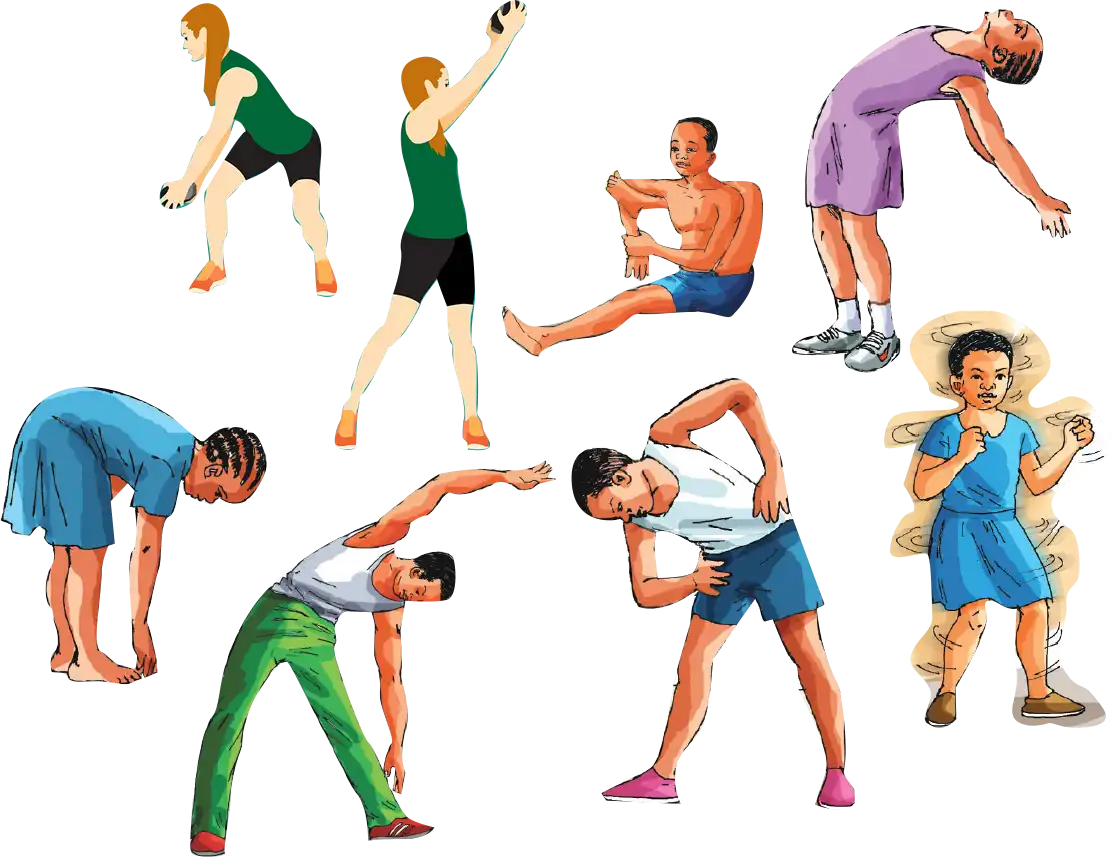Lesson Note on Moving Our Body Parts
Physical & Health Education
Theme: Fundamental movements & rhythmic activities
Topic: Non-locomotor movements
Sub Topic: Non-locomotor movements
Date: dd/mm/yyyy
Class: Basic One, Two & Three
Duration: 35 Minutes
No of Learners: 30
Learning Objectives:
By the end of the lesson learners should be able to:Describe / defined non-locomotor movements.
Non-locomotor movements can be described as moving on the spot without going anywhere.List and demonstrate different types of non-locomotor movements.

- Twisting: This happens when you rotate a part of your body without moving your feet.
- Bending: Bending occurs when you make your body curve forward, backward, downward or sideways.
- Stretching: This is when you bend and unbend parts of your body.
- pulling: This is when you draw somebody or something nearer to you.
- Pushing: This occurs when you press on something so that it moves forward.
- Turning: This occurs when you rotate the body without moving your legs.
- Shaking: This simply means shaking your body. For example, a dog shakes water out of its body when it is wet.
- Swinging: This is to move back and forth while suspended from above.
Rationale:
It is important to have a mature level of non-locomotor skills, due to the applicable nature of these skills to specific activities such as gymnastics, dance, martial arts, skating, skiing, horseback riding, track & field activities, amongst others.
Prerequisite/Previous knowledge:
Learners have learnt locomotor movements.Learning Materials:
TV/VCR or DVD player, flashcards, poster or wall paper, large open space.Reference Materials:
Physical and Health Education for Primary Schools by A. Ayegbusi et al.Lesson Development:
| STAGE | TEACHER'S ACTIVITY | LEARNER'S ACTIVITY | LEARNING POINTS |
|---|---|---|---|
| INTRODUCTION full class session (3 mins) | Teacher checks learners’ readiness and sports uniform. | Peace and values education: This is developed through following instructions and respect of game rules and safe play. |
|
| Opening discussion: (1 min) | Ask a question related to locomotor movement.
|
| Confirming the previous lesson. |
| Warm-up: 2 min | Let learners perform warm-up exercises and stretching exercises. | Learners jogging around the ground with maintaining a medium speed for one minute, raise and rotate hands according to teacher’s signals. | Inclusive education: Allow the learner with a missing hand to use feet in the place of hands, for medium hearing disability: Be always near during instructions, use hand signs or tasking the most skilled learner to help him/her. |
| Stretching: 2 min | Ask one learner to lead stretching exercises and provide support. | Learners perform general stretching exercises focusing on body parts. | |
| Development of the lesson: (15 mins) | Teacher asks learners, in the exercises we just performed, at some time you move your body while changing position (e.g jogging - teacher should recap learners that they have learnt that jogging is an example of locomotor movement), at another time you move your body while in the same position (e.g stretching). What kind of movement do you think this will be called? The teacher writes learners comments on the board. |
Learners expected to respond. Non-locomotor movement |
Developing the idea of the concept of the topic, Non-locomotor movements. |
| The teacher asks learners to act and list other types of exercises they can perform while still in the same position, that is, without moving from one place to another. The Teacher may give learners a prompt (by twisting, bending, stretching, pushing, turning, shaking his body) and get learners to discuss their views in group activities. Alternatively, the teacher may display pictures/posters on non-locomotor movements or pictures on learners textbook and asks learners to describe and list what they see in the pictures. 
|
Learners expected response:
|
Types of Non-locomotor movements. | |
| Evaluation. Full class session (10 mins) | Ask the following questions to evaluate the achievement of the set objectives.
|
Learners expected response:
|
Confirming the achievement of the set objectives. |
| Conclusion, full class session (3 mins) | The teacher lets learners to perform cool-down exercises | Moves their body slowly and relaxing arms in a different direction following instructions - up, down, up up, up, down, down, up, ... | Communication: This is developed through answering questions verbally and interpreting of silent signs of teammates during the exercises. |
| ASSIGNMENT | The teacher gives learners a take home.
|
Learners answer other questions. | Improving their level of understanding of non-locomotor movements. |